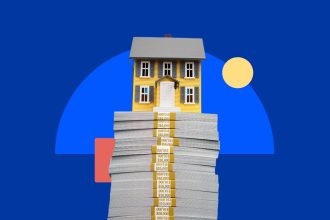Weekend Images Inc./Getty Images
Key takeaways
- A cash-out refinance offers benefits like access to money at potentially a lower interest rate, plus tax deductions if you itemize.
- On the down side, a cash-out refinance increases your debt burden and depletes your equity. It could also mean you’re paying your mortgage for longer.
- If you don’t want to replace your entire mortgage with a new loan, you can also consider using a home equity loan or a home equity line of credit (HELOC) to take out a smaller chunk of your equity.
A cash-out refinance allows you to convert a portion of your home’s equity into money you can use for other expenses and financial goals. Some homeowners use the funds to consolidate debt, fund home improvements or pay for higher education costs. Others put the money toward starting a business, investing in rental properties or making other big-ticket purchases. Whatever you’re hoping to accomplish by tapping into your home’s equity, review the pros and cons of a cash-out refinance before starting to compare rates.
What is a cash-out refinance?
In a cash-out refinance, you replace your existing mortgage with a new loan for a larger amount. This new loan pays off the original mortgage and provides additional cash you can use for any purpose. The cash comes from your home’s equity.
Many cash-out refinance lenders allow you to access up to 80 or 85 percent of your home’s value. However, this amount could vary, depending on your creditworthiness, the property type and your current mortgage. Generally, lenders require you to maintain at least 15 to 20 percent equity in your home (though there are exceptions) after a cash-out refinance. That means, if you recently bought a home with a low down payment, you might not qualify for this type of refinance.
Cash-out refinance pros and cons
As with any financial decision, there are benefits and drawbacks to a cash-out refinance to consider:
Cash-out refinance pros
- Access to a large sum: The biggest upside of a cash-out refinance is that you get the money you need by unlocking home equity you already have.
- Lower interest rate: A cash-out refinance might have a lower interest rate compared to credit cards and personal loans.
- Predictable payments: If you refinance to a new fixed-rate loan, your monthly principal and interest payments won’t change. That’s not the case with home equity lines of credit (HELOCs), which generally carry variable rates.
- Possible tax deductions: When you file your taxes, you can deduct the interest you pay on the cash you took out so long as you use the funds to make eligible home improvements.
- Potential to boost your credit score: If you use a cash-out refi to consolidate higher-interest debt, your credit score could improve.
Cash-out refinance cons
- You owe more: Because you’re taking out a larger loan amount, your overall debt load increases. No matter how close you were to paying off your original mortgage, the cash-out raises your debt level.
- You might be kicking your debt down the road: If you’re cashing out to pay off high-interest debt, take a long pause. Make sure you’ve addressed whatever spending issues led you to run up the debt in the first place. Otherwise, you might find yourself in a debt spiral.
- Closing costs: Just as you paid closing costs on your original mortgage, you’ll pay similar expenses when you refinance. (The good news: Refinance fees aren’t nearly as expensive as the closing costs on a home purchase.)
- Foreclosure risk: Your home is the collateral for the cash-out refinance, so if you don’t repay the loan, you could lose your home.
Should I get a cash-out refinance?
A cash-out refinance could be ideal if you qualify for a better interest rate than you currently have and plan to use the funds to improve your finances or your property. This could include upgrading your home to boost its value or consolidating high-interest debt to free up room in your budget.
If you can’t get a lower interest rate, however, a cash-out refinance might not be the best move, especially if you refinance to a new 30-year loan.
In addition, if you expect to sell your home in the short term, it might not make sense to do a cash-out refinance; you’ll have to repay the larger balance at closing.
Here’s when it might make sense to get a cash-out refinance:
- Lower interest rate: When you can lower the interest rate on your mortgage
- Improved credit score: When you can improve your credit by using the proceeds to pay off or consolidate debt
- Tax deduction: When you intend to do home renovations that will improve your property, which can allow you to qualify for a tax deduction on your federal tax deduction
- More competitive borrowing cost: When the cost to borrow is less than other types of loans such as a home equity loan or a personal loan
Alternatives to a cash-out refinance
A cash-out refinance might not be right for you. If so, there are other options that allow you to borrow against your home’s equity, including:
- Home equity loan: Home equity loans provide a lump sum payment similar to a cash-out refinance. You pay back the funds in installments, usually at a fixed interest rate that’s lower than many other types of consumer lending options.
- HELOC: A home equity line of credit (HELOC) is a revolving credit line that functions much like a credit card. With a HELOC, you can borrow what you need, repay the amount borrowed and then borrow again. HELOCs come with a specific draw period during which you can continue to borrow funds as needed. Once the draw period closes, you pay back the remaining balance in installments.
Both options are often quicker and less expensive to get than a cash-out refi. However, they also use your home as collateral and could come with higher interest rates compared to refinancing.
What are the steps to getting a cash-out refinance?
The steps to getting a cash-out refinance will feel a lot similar to getting your first mortgage. You’ll need to submit your financial documentation to show your ability to repay the loan, and you’ll get another property appraisal to help the lender assess its fair market value. Here’s a rundown of what to expect:
- Calculate your equity: Start by calculating the equity in your home. This will help you understand how much you could potentially cash out.
- Get your financial records in order: Be prepared to provide income, asset and liability documentation. You’ll also need to provide information about your existing mortgage and your property. If you’ve recently had an appraisal, be ready to show proof of that, as well.
- Shop lender offers: Compare at least three mortgage lenders and their rates, fees and terms. The best rates typically go to those with excellent credit — at least a 740 credit score.
- Apply: Next up, you apply for a cash-out refinance. Once an appraiser determines your home’s value, your lender can inform you how much you could get in a cash-out refi.
- Close the loan: Upon approval, you’ll finalize the loan terms and sign off on the closing paperwork. After this, you’ll receive the cash difference between your new, larger loan and the previous mortgage balance, minus any associated closing costs.
- Think: Cash-out refinances have a three-day rescission period, during which you can decide to cancel the entire loan. As long as you’re confident in your decision, you’ll get the cash after that three-day period is complete.
FAQ
Read the full article here














